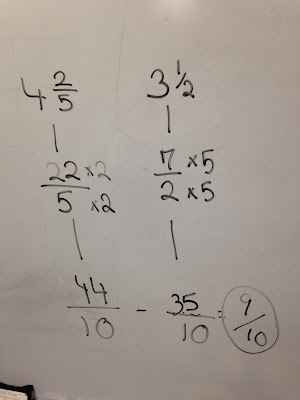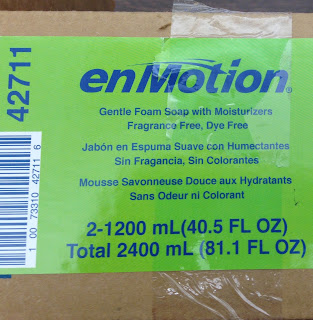58 students on a field trip. 4 students can fit in a van. How many vans are needed?
I gave this problem to four of my basic skills students, each one individually. They worked it out on a big whiteboard in my room. All fourth graders, just finishing up a unit on division. Here's who they are and how they responded:
I. Daiba
Daiba has been in our district since 2014, but she's new to our school, one of the several dozen students repatriated back last fall due to the opening of an ELL class. She's since placed out, and although she does have some trouble expressing herself, her English sounds pretty good to me. She's compliant, sweet, quiet and shy. She's had trouble making friends. I never see her interacting with other students. Sometimes I wonder if it's because she's only one of two girls in the entire school who wears a hijab, or if it's just because she's socially awkward.
Daiba likes coming to my room, and I pull her several times a week in addition to pushing into her class. We've worked on multi-digit addition and subtraction computation, place value concepts, and rounding. She asks insightful question. She started work on the problem right away, using the partial-quotients algorithm she learned in class.
When I asked her how many vans would be needed, she responded 14. I asked her about the remainder, and she explained that 2 students were left. I asked her whether or not they'd be going on the trip, and she said no, they wouldn't be going. I didn't respond. After a moment or two a little smile broke across her face.
Her: That's not nice to leave them behind.
Me: No, it's not. What are you going to do about it?
Her: I could put them in another van.
Me: Then how many vans will you need?
Her: Fifteen.
Me: (smiling) Back to class with you!
II. Justin
Justin's the boy with the buzz cut. I know him pretty well, having worked with him all of last year, and in my experience he's a happy-go-lucky kid who likes to draw, collect toy cop cars, and ride dirt bikes. But he's had a rough year. He's been unable to connect with his teacher, and has spent a good part of class time emotionally shut down and unavailable for learning. Crying, visits to the school counselor, behavior modification plans, teacher team meetings, parent phone calls and conferences; clearly Justin is working through something and we're doing what we can to help him get through the year in one emotional piece.
As a math learner, Justin has good number sense and an ability to manipulate numbers in his head. But he doesn't like to write things down, and is easily discouraged. When I first gave him the problem, he spent several minutes staring at the whiteboard, twirling an expo marker in his hand. I couldn't guess what was going through his mind. Was he thinking about the problem? Would he refuse to engage? Should I say something? I waited for what seemed like an eternity. Finally he uncapped the marker, drew four tally marks, and enclosed them in a drawing of a van. He continued to do this, keeping a running total on top of each one. When he got to 56, he drew two more tallies and enclosed them in another van.
After he was finished, I asked him if he could attach an equation to what he had done. Without hesitation, he wrote 58/ 4 = 14 R 2. I asked him how many vans were needed, and wrote the answer, 15, on the whiteboard. I asked him why he didn't use the partial quotients algorithm he learned in class from his teacher.
Him: It would be too much work.
Me: (pointing to all he had written on the whiteboard) This seems like a lot of work.
Him: It's not for me.
Me: What if there had been 158 kids going on the trip?
Him: I don't know.
Me: With that many kids, doing it the way you learned in class would make things easier.
Him: (No response.)
Me: (Deciding to quit while I was ahead, thinking I was lucky he had even engaged with the
problem) OK, you can go back to class.
III. Tashana
Tashana has personality coming out of her ears. If you were out sick, she could run the class. She knows exactly where everybody is supposed to be at all times. But she's a little too much of a busybody, and you can often find her in the hall along with a few other girls and teacher in the middle trying to mediate a dispute. Like Justin, I know her pretty well, having worked with her last year. When I ask her to come and work with me, which happens several times a week, she gets up very slowly from her desk and looks furtively around the room. I worry she doesn't like being taken out of class, if only for 10 minutes, but she invariably warms up to her usual bright self. I know that her outgoing persona hides a very scared, often confused math learner. In my room she doesn't have to worry about what everyone else in class is doing, which more often than not is something she has trouble understanding.
Tashana and I have spent a good part of the year developing concepts of place value and working on multi-digit computation, especially subtracting. She likes finding the difference between two numbers by counting up on an open number line, and she's gotten pretty good. But the standards call for the use of the traditional algorithm, and here we've gotten somewhat stuck. As I explained the problem to her, she noted the information on the whiteboard. She drew 58 circles on the board, representing the kids, and then circled groups of four.
Me: So how many vans will you need?
Her: 14.
Me: What are those two circles left over?
Her: That's two kids.
Me: What about them? Are they going on the trip?
Her: Does a van have to have four kids in it?
Me: Well that's up to you!
Her: They could go in another van.
Me: Nice! You can go back to class now.
IV. Vanessa
Vanessa squints a lot, but no matter how hard she tries, the math is blurry. She's another repatriated ELL student. She's been in the program for years, and her teacher tells us that she thinks Vanessa's learning issues extend beyond just language. She's quiet. Her voice never rises above a soft murmur, and she has a habit of responding to questions with answers that themselves sound like questions. She's in the same class as Daiba, and I've wished they could somehow find and befriend each other. Two newcomers, outsiders looking in on a rambunctious, lively class, but it hasn't happened.
Vanessa's math learning is hard to pin down. Just when I think she has a handle on a concept, it mysteriously slips away. Concepts that I think she'll find confusing, like fractions, she readily grasps. But she'll solve a problem like 13 - 9 by counting backwards from 13 on her fingers and get an answer of 5. Her first move when I gave her the problem was to start drawing circles with four dots in each. She did this three times, stepped away from the whiteboard, and after some consideration, erased what she's done.
She then set up a division problem using a
partial quotients method I've taught her, useful for envisioning partitive division. But this is a measurement division scenario, and I was worried that this might confuse her. Nevertheless, she arrived at an answer.
Me: So how many vans will you need?
Her: 14 remainder 2?
Me: What does that mean? What's 14 remainder 2 vans?
Her: 16?
Me: (after a few moments of thought) When you first started to solve the problem, you drew circles with dots in them. Why did you erase them?
Her: (no response)
Me: I'd like you to go back and solve it that way.
Her: 15?
Me: Is it 15 or 16?
At this point Vanessa stepped back and squinted hard. The minutes ticked by in silence. She had gotten the right answer, even though she had made a mistake along the way. Was she waiting for me to intercede? Was she still not sure? I know all about wait time, but how long are you supposed to wait?
My patience paid off. Vanessa went back to the board and corrected her mistake. She saw clearly what she needed to do. She carefully recounted the dots, erased the 8 in 58 and changed it to a 6...
...erased two dots, and was left with 14 vans with four kids in each and 1 van with two kids.
Me: So how many vans?
Her: 15?
Me: Are you asking me or telling me?
Her: 15.
Me: By the way, that remainder two from before? Those are the two kids in the fifteenth van. Now back to class. I don't want you to be late for lunch!
Four students, one question. Two weeks from now, they'll all take the PARCC. There will be questions on that test much more complex than this one: bigger numbers, text-laden scenarios, multi-step problems. How will Daiba, Justin, Tashana, and Vanessa respond? Will they have enough time? What will they see reflected in the chromebook screen? Will the best they have to offer be thrown in the trash with the rest of the class's scrap paper? My wish for them is to come through emotionally unscathed, because I love them all.

















































